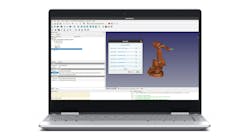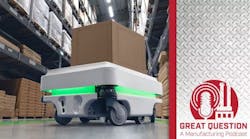As its name implies, material handling is the movement, storage, and logistic control of materials as they travel throughout a supply chain system. From the input of components into a manufacturing plant, to warehousing parts and the production and distribution of assembled products, to their disposal, recycling, and reuse.
Material handling has long been a tedious, physically demanding job. Workers expose themselves to danger every time they conduct tasks such as manual labor such as loading and carrying heavy parts or moving loaded pallets with forklifts onto towering storage racks. In addition, material handling processes are plagued by human error and inefficiencies.
To material handling industry insiders, the answer to these problems and many more is robotics.
Robotic Material Handling
The Stanford Arm, an all-electric, 6-axis articulated robot, was invented in 1969 at Stanford University. The number of axes was vital since it determined the mobility, accuracy, and degrees of freedom of which the robot was capable. The 6-axes of the Stanford Arm allowed it to move in the x, y, and z planes, as well as to position small parts of itself using roll, pitch, and yaw movements. This was truly revolutionary.
The Stanford Arm was licensed to Kawasaki Industries and GKN. Using its innovative design, these two companies created robotic material handling systems capable of moving heavy payloads at throughput speeds far beyond the capabilities of a human being. At first, PLCs provided a means for rudimentary programming and control of industrial robots. Not long after, the PLCs were replaced by increasingly sophisticated automation software running on industrial networks.
A major hallmark of robotic automation was celebrated in 2003 when Kiva Systems introduced the first Autonomous Mobile Robot (AMR) for material handling. Shortly after its launch, Kiva Systems was purchased by e-commerce giant Amazon which immediately put its robots to use in warehouses.
Robotic and material handling equipment and systems are now capable of pick-and-place, dispensing, packing, assembly, machine tending, palletizing, and part transfer tasks, all performed while delivering consistent and repeatable results. These complex tasks are now commonplace applications on the plant floor and in warehouses and are often aided by the integration of embedded 3D vision systems that help the robots operate with pinpoint accuracy. Robotics also represent an additional source of data on the logistics operations taking place in a facility.
Material handling robots operate unattended around the clock in warehouses and factories across industries, eliminating costly bottlenecks and increasing productivity without putting additional strain on the workforce. In addition, they’ve been proven to reduce the risk for workers who previously handled dangerous materials like glass and sharp metals, or risked crushing injuries under heavy payloads. Best of all, many robotic material handling processes and systems, including AGVs, AMRs, and cobots, use wireless devices, so they are free to roam untethered to Ethernet cables.
Wireless Connectivity in Robotic Material Handling
Just as the Stanford Arm was a landmark breakthrough decades ago, wireless Ethernet connectivity is now ushering in a new age of innovation for robotic material handling manufacturing process here. In the warehouse or plant, Wi-Fi links RF scanners, mobile carts, AMRs, IP cameras, smart sensors, stacker cranes, laptops, and other critical devices to the same LAN, efficiently transmitting and receiving real-time operational data.
An AMR is a robotic material handling systems application within a warehouse. Here’s the catch: Factories, warehouses, and distribution centers are fixed infrastructure. Physical obstacles like concrete walls or steel doors standing between a router and a wireless device can block signal reception. The resulting weak connection can lead to a lack of coordination between machines human workers or equipment or even cause sensors to disconnect, jeopardizing employee safety.
Another connectivity issue can be the share size of a building. Today's average warehouse is more than 180,000 square feet, more than 40% larger than the average 20 years ago. They're also filled with customers using more products and filling orders more quickly than ever before. Wi-Fi signals can only travel so far, so staying in contact with wireless clients presents a serious challenge.
Wi-Fi signals will usually reach about 150 feet for a 2.4 GHz frequency. Using a 5 Ghz frequency, for example, you will get about 50 feet of reach. So, as an AMR travels further and further away from the router, the Wi-Fi signal will grow weaker and weaker until it finally drops completely.
Antaira Rapid Roaming Technology for Material Handling
Fortunately, Antaira has you covered. By deploying Antaira Rapid Roaming Technology throughout your warehouse or plant, wireless reception remains uninterrupted for mobile Wi-Fi clients. Rapid Roaming actively and accurately monitors its surroundings and prepares new possible Access Point (AP) opportunities before the client suffers the classic die-down and drop-off processes. Without Rapid Roaming Technology, drops in Wi-Fi communication can last a minute or more, long enough to impact operations, efficiency, and safety.
Antaira Rapid Roaming leverages the benefits and advantages of the IEEE 802.11r standard. Also known as Fast BSS Transition, IEEE 802.11r significantly reduces the length of time that connectivity is interrupted between a mobile client and the Wi-Fi infrastructure. The 802.11r standard works by preconfiguring authentication and QoS. This allows stable data throughput without delays caused by the regular authentication process.
AMRs and AGVs are two examples of robots that require multiple access points to stay connected as they move along a given path. With Antaira Rapid Roaming the switchover between APs and robot is below 150 milliseconds (ms) so there is virtually no data loss. Rapid Roaming detects, authenticates, and auto-connects industrial robots to the new AP while simultaneously dropping the current one.
When you apply Rapid Roaming Technology, you'll need to use an AP with the same SSID and security key. Once Rapid Roaming is enabled, the client and system will automatically scan for surrounding APs. Rapid Roaming has two modes of channels for scanning.
The first mode is “standard” for when all the channels are scanned. The second mode is “intelligent”, and it works when a client device, for instance, goes back and forth along the same APs multiple times. In intelligent mode, Rapid Roaming learns those AP channels and looks for them automatically, further accelerating the cycle time of the reconnection process.
It's not uncommon for older plants and warehouses to have a legacy Wi-Fi network infrastructure that does not support 802.11r. Again, Antaira has you covered. By fitting AMRs, AGVs, and mobile robots with an Antaira ARS-7235-AC an organization can implement Rapid Roaming technology at a fraction of the cost of installing a new wireless network.
The Antaira ARS-7235-AC is a wireless access point, client, bridge, and repeater with router capabilities—all in one compact, flexible design that fits easily onto AMRs, AGVs, robots, and other mobile Wi-Fi devices.
According to the Association of Advancing Automation, 95% of warehouses today are not yet automated. Deploying robotic material handling in your warehouse or factory represents an excellent opportunity for managers to gain a competitive advantage. Antaira offers industrial routers, industrial wireless access points, and other various industrial wireless devices to help you on your journey.
Contact Antaira today at [email protected] or call (714) 671-9000.












